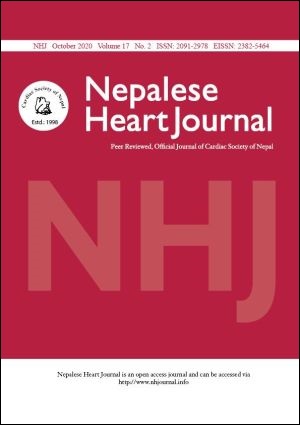Prevalence of Myocardial Infarction with Non-Obstructive Coronary Arteries in Western Nepal
DOI:
https://doi.org/10.3126/njh.v17i2.32677Keywords:
Coronary Angiography, Myocardial infarction, Myocardial infarction with non-obstructive coronary artery diseaseAbstract
Background and Aims: It is well known that ST segment elevation myocardial infarction results from complete occlusion of a coronary artery supplying that area. However, in up to 15% of patients with clinical diagnosis of myocardial infarction, early angiography reveal either non-obstructive or normal coronary artery. This subgroup of disease, myocardial infarction (MI) with non-obstructive coronary arteries (MINOCA), represent a diagnostic and therapeutic challenge to clinicians. We aimed to determine prevalence and clinical profile of patients with MINOCA in current study.
Methods: This is a retrospective, observational study conducted in cardiology department of Manipal Teaching Hospital, Pokhara, Nepal from 6th April 2014 to 5th April 2019. Patients with age ≥18 years and clinically diagnosed acute myocardial infarction who underwent coronary angiography without prior use of thrombolytic agents were selected. Data were analyzed using the software SPSS for windows version 18.
Results: A total of 177 patients’ underwent early coronary angiography without prior use of thrombolytic agent. The prevalence of MINOCA was 13.5% (n=24) in our study population. MINOCA patients were younger (p<0.001) compared to non-MINOCA. Smoking, systemic hypertension, access through femoral route and depressed left ventricular ejection fraction were significantly lower in MINOCA patients (p<0.05, for all).
Conclusion: The prevalence of MINOCA was high (13.5%) in our study. Prospective studies are needed to conclude its high prevalence and to look for other associated factors and etiology.
Downloads
Downloads
Published
How to Cite
Issue
Section
License
This license enables reusers to distribute, remix, adapt, and build upon the material in any medium or format, so long as attribution is given to the creator. The license allows for commercial use.




